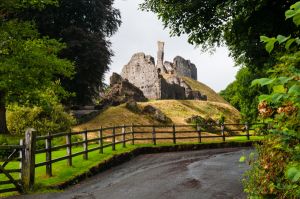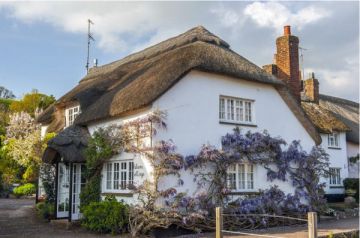
The impressive ruin of this, the largest castle in Devon, stands on the banks of a river in the foothills of Dartmoor. The central keep is still impressive atop its motte, and there are excellent walks through the woodlands surrounding the castle.
History
Okehampton Castle was constructed shortly after the Norman Conquest, at a strategic place where four major roads crossed. The probable builder was Baldwin de Brionne, who was appointed Sheriff of Devon by William the Conqueror. The castle is mentioned in the Domesday Book of 1086, so it must have been built very shortly after the Conquest.
The castle then passed to the Courtenay family, and High Courtenay, later to become the 1st Earl of Devon, rebuilt the Norman fortress in its current form around 1297. For the next 240 years, Okehampton was a major residence for the Courtenays, who owned vast estates throughout the county.
In 1539 Henry Courtenay was executed by Henry VIII on a charge of treason, and the castle was abandoned and left to decay, the stones scavenged by local people for building projects.

The castle remains are from two main periods; the earliest Norman work and the later Courtenay fortress. From the Norman period are the earthworks, which created a large motte between a pair of bailey enclosures, with a square keep atop the mound.
Only the eastern bailey was rebuilt in stone by Hugh Courtenay. Among the surviving structures built by Courtnay are a hall and solar, lodging for retainers, and a chapel with an apartment for a priest attached.
Now that I've said the remains are from two periods, I'm going to contradict myself; recent finds have unearthed Roman tiles and pottery, suggesting that the site may have been occupied by a Roman villa long before Baldwin and his Normans arrived.
About Okehampton
Address: Castle Lane,
Okehampton,
Devon,
England, EX20 1JA
Attraction Type: Castle
Location: 1 mile southwest of town centre
Website: Okehampton
English Heritage - see also: English Heritage memberships (official website)
Location
map
OS: SX584 942
Photo Credit: David Ross and Britain Express
HERITAGE
 We've 'tagged' this attraction information to help you find related historic attractions and learn more about major time periods mentioned.
We've 'tagged' this attraction information to help you find related historic attractions and learn more about major time periods mentioned.
Find other attractions tagged with:
NEARBY HISTORIC ATTRACTIONS
Heritage Rated from 1- 5 (low to exceptional) on historic interest
Nine Maidens Stone Circle - 2.4 miles (Prehistoric Site) ![]()
Finch Foundry - 3.6 miles (Historic Building) ![]()
Sampford Courtenay, St Andrew's Church - 4.6 miles (Historic Church) ![]()
Scorhill Stone Circle - 6.6 miles (Prehistoric Site) ![]()
Tolmen Stone - 6.8 miles (Prehistoric Site) ![]()
Shovel Down Stone Rows - 7.5 miles (Prehistoric Site) ![]()
Spinsters' Rock Burial Chamber - 7.7 miles (Prehistoric Site) ![]()
Lydford Castle - 8.1 miles (Castle) ![]()













